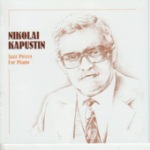Nikolai Kapustin’s scintillating, boundlessly inventive piano music is the ultimate in “written out jazz”, as those who’ve heard Hyperion’s Kapustin releases with Marc-André Hamelin and Steven Osborne might well agree. Yet no one quite plays Kapustin like Kapustin himself. His technique yields nothing in power and virtuosity to Hamelin and Osborne, yet Kapustin often infuses his music with a stronger sense of swing and idiomatic fluency. I’ll cite several examples.
Osborne plays the First sonata’s rhapsodic opening in long, suave legato lines, while Kapustin’s sparser pedaling and more accentuated approach conveys more harmonic tension and improvisatory momentum. In the Op. 41 Variations, Hamelin’s dotted rhythms are accurate but slightly stiff, while Kapustin’s resilient backbeats evoke a hidden rhythm section.
Similar differences characterize the Op. 40 Etudes. Hamelin’s phrase tapering in No. 7 prettifies the loping Dave Brubeck-ish gait present in Kapustin’s gutsier, more elemental reading. On the other hand, while Kapustin’s slower tempo for No. 5 clarifies the melodic shape of the rapid left-hand figurations, the Prokofiev-like bite in Hamelin’s faster, more uniformly-voiced rendition proves equally valid. It’s also tough to choose between Hamelin’s dazzling sweep in No. 3 (the Toccatina) and Kapustin’s slower, harder hitting interpretation.
There’s nothing to complain about regarding the original mid-to-late 1980s Melodiya engineering, save for a slightly congested quality in loud passages. Thanks to Boheme for making this once hard-to-find treasure available again.
































